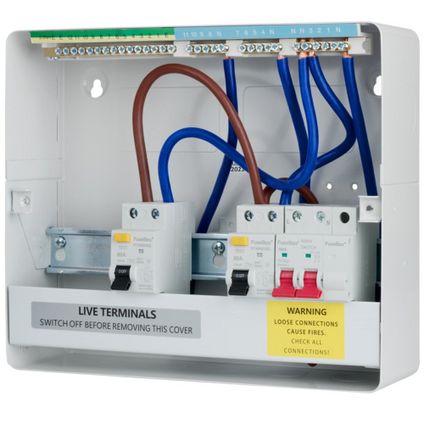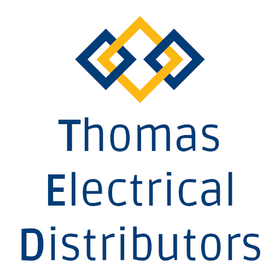Consumer Units - A Complete Guide
Choosing A Consumer Unit
Choosing a consumer unit, also known as a fuse box or distribution board, is an important decision for any homeowner or building owner in the UK. This device serves as the main distribution point for electrical circuits within a building and is responsible for protecting against overloading and short circuits. With a wide range of options available in the market, it can be difficult to determine which one is best for your needs. In this article, we will discuss the key factors to consider when choosing a consumer unit and provide an overview of the different types available.
Factors to Consider
- Number of Circuits
- Protection Requirements
- Building Regulations
- Budget
- Style and Appearance
Types of Consumer Unit
Main Switch RCBO Consumer Units
A Main Switch / RCBO Consumer Unit is a type of electrical consumer unit that includes a main switch that can be used to turn off the electrical supply to the entire property. The main switch is typically located at the point where the electrical supply enters the property and acts as the main point of control for the electrical installation.

Dual RCD Consumer Units
A Dual RCD Consumer Unit is a type of electrical consumer unit that includes two residual current devices (RCDs), which provide protection against electric shock and minimize the risk of electrical fires.
Dual RCD Consumer Units are typically used in residential and commercial electrical installations to provide enhanced protection against electric shock, earth fault currents, and fire hazards. The Dual RCD Consumer Unit is installed at the point where the electrical supply enters the property and acts as the main protection device for the electrical installation.
The Dual RCD Consumer Unit works by monitoring the flow of electrical current in the installation and detecting any disruptions in the normal flow of current, such as those caused by an electric shock or an earth fault. If a disruption is detected, the appropriate RCD trips and interrupts the electrical supply, effectively cutting off the power and preventing any harm from being caused.
The use of two RCDs in a Dual RCD Consumer Unit provides an additional layer of protection and increases the reliability of the electrical installation. This can be especially important in high-risk areas, such as bathrooms, kitchens, and outdoor areas, where the risk of electric shock or fire is higher.They look a little like this..

RCD Incomer Consumer Units
An RCD Incomer Consumer Unit is a type of electrical consumer unit that includes a residual current device (RCD) for the incoming supply. An RCD is a safety device that is used to protect against electric shock and minimize the risk of electrical fires.
An RCD Incomer Consumer Unit is typically used in residential and commercial electrical installations to provide protection against electric shock, earth fault currents, and fire hazards. The RCD Incomer Consumer Unit is installed at the point where the electrical supply enters the property and acts as the main protection device for the electrical installation.
The RCD Incomer Consumer Unit works by monitoring the flow of electrical current in the installation and detecting any disruptions in the normal flow of current, such as those caused by an electric shock or an earth fault. If a disruption is detected, the RCD trips and interrupts the electrical supply, effectively cutting off the power and preventing any harm from being caused.
EV Charging Consumer Units
An Electric Vehicle (EV) Charging Consumer Unit is a specialized consumer unit that is designed to manage the charging of electric vehicles. It is typically installed in homes or commercial buildings to provide a convenient and safe way to charge electric vehicles.
An EV Charging Consumer Unit typically includes a charging station and a control unit that manages the charging process. The charging station is connected to the electrical supply, and the control unit ensures that the charging process is safe and efficient. It may also include protection devices, such as circuit breakers or residual current devices, to ensure the safety of the charging process and the surrounding environment.
The Fusebox EV consumer unit is designed to be easy to use, with simple controls and clear displays to provide information about the charging process, such as the charging status, the charging rate, and the estimated time to full charge. Some consumer units also include features to manage the charging process, such as the ability to set charging schedules or limit the charging rate.

Dual Tariff Consumer Units
A Dual Tariff Consumer Unit is an electrical consumer unit that is designed to manage the supply of electricity to a property and allow for different electricity tariffs to be applied at different times of the day.
A dual tariff consumer unit is typically used in homes and businesses that are connected to a time-of-use electricity tariff, where the price of electricity varies depending on the time of day it is used. The consumer unit allows the electricity supply to be split into two separate circuits, with each circuit connected to a different tariff.
For example, electricity used during peak hours, when demand for electricity is high and prices are higher, can be directed to one circuit, while electricity used during off-peak hours, when demand is lower and prices are lower, can be directed to another circuit. This helps to reduce electricity costs by taking advantage of the lower electricity prices during off-peak hours.
A dual tariff consumer unit typically includes two separate meters, one for each tariff, and a control system that switches the supply between the two tariffs depending on the time of day. The consumer unit is typically installed by an electrician, and the electricity supplier is responsible for setting the tariffs and installing the meters.

Garage Consumer Units
A Garage Consumer Unit is a type of electrical consumer unit that is designed to control and distribute the electrical supply in a garage. It is typically installed in a garage to provide power to electrical appliances, lighting, and other equipment.
A Garage Consumer Unit typically includes a main switch and a number of circuits, which are used to control the supply of electricity to different areas of the garage. The circuits may be protected by residual current devices (RCDs), circuit breakers, or rcbos, which are used to protect against electric shock and minimize the risk of electrical fires.
Devices
What is an RCBO?
An RCBO (Residual Current Circuit Breaker with Overload Protection) is an electrical protection device that combines the functions of an RCD (Residual Current Device) and a MCB (Miniature Circuit Breaker) into one unit. It is used to enhance the safety of electrical installations by providing protection against both electrical shock and overloading of electrical circuits.The RCD component of the RCBO is designed to detect any residual current that may flow in the circuit and trips the breaker if an imbalance is detected, which helps to prevent electrical shocks. The MCB component provides protection against overloading of electrical circuits, which can cause electrical fires.
RCBOs are commonly used in residential, commercial, and industrial settings, and are particularly useful in areas where there is a high risk of electrical shock, such as bathrooms and kitchens. They are also used in applications where power surges or other electrical hazards may be present.
What is an MCB?
An MCB (Miniature Circuit Breaker) is a type of electrical protection device that is used to protect electrical circuits against overloading, short-circuits, and other types of electrical hazards.
MCBs work by automatically breaking the electrical circuit when the current exceeds a certain level, which helps to prevent damage to the electrical system and prevent electrical fires. MCBs are commonly used in residential, commercial, and industrial electrical installations to provide circuit protection and ensure the safe operation of electrical systems.
MCBs come in different sizes and ratings to suit different electrical needs, and are usually installed in a consumer unit (also known as a fuse box or distribution board) as part of an overall electrical protection system. They are designed to be easily replaced if they trip, and are a relatively simple and inexpensive way of ensuring the safety of electrical installations.
What is an SPD?
A Surge Protection Device (SPD) is an electrical device that is used to protect electrical equipment and systems against power surges and voltage spikes.
A power surge is a sudden, brief increase in the electrical voltage that can damage or destroy electronic devices and electrical equipment. Voltage spikes, on the other hand, are short-lived increases in voltage that can cause similar problems. SPDs work by diverting any excess voltage and current away from the protected equipment and into the electrical grounding system, which helps to prevent damage.
SPDs are commonly used in residential, commercial, and industrial settings to protect sensitive electronic equipment, such as computers, televisions, and other appliances. They are also used in electrical power distribution systems to protect against lightning strikes and other types of power surges.
SPDs come in different forms, including plug-in surge protectors, surge protection strips, and hard-wired SPDs that are installed directly into the electrical system. The level of protection provided by an SPD is usually rated in joules, which indicates the amount of energy that the device can absorb before it fails.
What is an AFDD?
AFDD stands for Arc Fault Detection Device. An Arc Fault Detection Device is a type of electrical safety device that is used to detect and prevent electrical arcs, which can cause electrical fires.
Arc faults occur when there is a disruption in the normal flow of electrical current, resulting in an electrical discharge, or arc, between conductors. These arcs can produce heat, which can start a fire if it is not detected and stopped in time.
AFDDs work by monitoring the electrical circuit for any signs of an arc fault and tripping the circuit breaker if an arc fault is detected. This helps to prevent electrical fires and ensure the safety of electrical systems.
AFDDs are commonly used in residential, commercial, and industrial electrical installations, and are typically installed in a consumer unit (also known as a fuse box or distribution board). They are especially useful in applications where there is a risk of arc faults, such as in older buildings with outdated electrical wiring, or in areas where there is a risk of electrical damage, such as in damp or humid conditions.
Find our full consumer unit range here!
